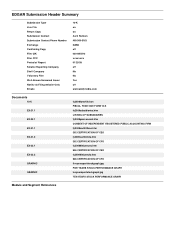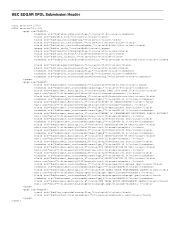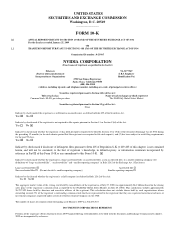NVIDIA 2008 Annual Report Download - page 10
Download and view the complete annual report
Please find page 10 of the 2008 NVIDIA annual report below. You can navigate through the pages in the report by either clicking on the pages listed below, or by using the keyword search tool below to find specific information within the annual report.
Additionally, in the fourth quarter of fiscal year 2009, we announced the NVIDIA Ion Platform, which combines the GeForce 9400 GPU with the Intel Atom
CPU. The combination enables netbooks, small form factor and all
-
in
-
one PCs to play rich media and popular games in high definition.
Our MCP strategy is to bring the benefits of GeForce GPUs to the most price sensitive categories while creating exciting platform architectures like SLI,
Hybrid SLI, and Enthusiast System Architecture, or ESA. ESA is a standard for system information protocol that links a PC system
’
s various critical components
– such as fan, power supply, smart chassis, GPUs, and motherboards. It enables a unified architecture for applications and users to control and optimize the
performance of their system. SLI, Hybrid SLI, and ESA are examples of how we create architectures that advance the capabilities of the PC.
Consumer Products Business
Our CPB is comprised of our Tegra and GoForce mobile brands and products that support netbooks, PMPs, PDAs, cellular phones and other handheld
devices. This business also includes license, royalty, other revenue and associated costs related to video game consoles and other digital consumer electronics
devices.
We believe that mobile devices like phones, music players, and portable navigation devices will increasingly become multi
-
function, multi
-
tasking, PCs. As
such, we anticipate the architecture of these devices will increasingly become more consumer PC
-
like and be capable of delivering all the entertainment and web
experiences that end users currently enjoy on a PC, but in a form
-
factor that fits nicely in their hands. Our mobile strategy is to create a computer
-
on
-
a
-
chip that
enables this experience. NVIDIA Tegra and GoForce mobile products implement design techniques, both inside the chips and at the system level, which result in
high performance and long battery life. These technologies enhance visual display capabilities, improve connectivity, and minimize chip and system
-
level power
consumption. NVIDIA Tegra and GoForce products can be found primarily in multimedia cellular phones and other handheld devices.
During fiscal year 2009, we launched the NVIDIA Tegra APX 2500 computer
-
on
-
a
-
chip. The NVIDIA Tegra APX 2500 is a computer
-
on
-
a
-
chip designed to
meet the growing multimedia demands of today's mobile phone and entertainment user In February 2009, we announced the NVIDIA Tegra APX 2600 computer
-
on
-
a
-
chip and that we have worked closely with Google, Inc., or Google, and the Open Handset Alliance to unleash Android, an open mobile phone software
stack, with the NVIDIA Tegra series of
‘
computer
-
on
-
a
-
chip
’
processors. The NVIDIA Tegra APX 2600 and 2500 enable a compelling user interface and high
-
definition video playback for a low
-
power, visually rich experience, and we expect that these products will be key to building next
-
generation Microsoft Windows
Mobile, Windows CE, and Android
-
based devices, including smartphones, PNDs, and PMPs.
Additionally, we also launched the NVIDIA Tegra 600 and 650 products, which are small, advanced, highly
-
integrated visual computer
-
on
-
a
-
chip products.
These products, which represent a single
-
chip heterogeneous computer architecture designed for low
-
power mobile computing devices, feature enhanced
multimedia functionality—including high definition, or HD, 1080p video and advanced 3D technology—and deliver many times the power efficiency of competing
products on a broad range of connected devices.
Additionally, in the fourth quarter of fiscal year 2009, we also introduced GeForce 3D Vision, a high
-
definition 3D stereo solution for the home. 3D Vision is
a combination of high
-
tech wireless glasses, a high
-
power infrared emitter and advanced software that transforms hundreds of PC games into full stereoscopic 3D.
Our Strategy
We design our products to enable our PC OEMs, ODMs, system builders, motherboard and add
-
in board manufacturers, and cellular phone and consumer
electronics OEMs, to build products that deliver state
-
of
-
the
-
art features, performance, compatibility and power efficiency while maintaining competitive pricing
and profitability. We believe that by developing 3D graphics, HD, video and media communications solutions that provide superior performance and address the
key requirements of each of the product categories we serve, we will accelerate the adoption of HD digital media platforms and devices throughout these
segments. We combine scalable architectural technology with mass market economies
-
of
-
scale to deliver a complete family of products that span from
professional workstations, to consumer PCs, to multimedia
-
rich cellular phones.
7























